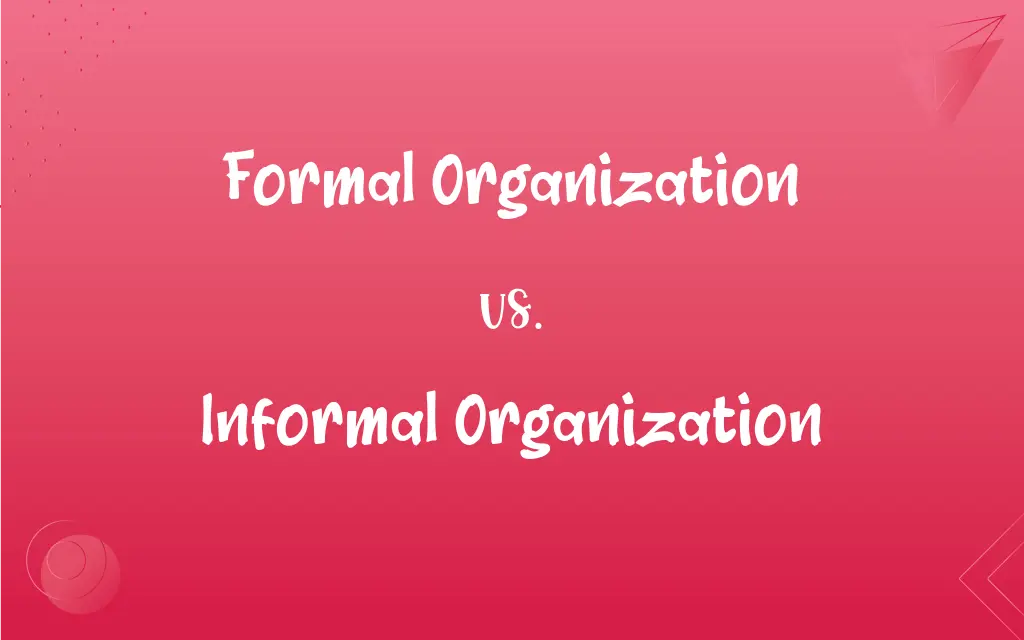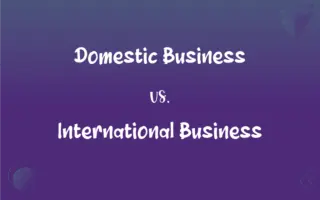Formal Organization vs. Informal Organization: What's the Difference?
Edited by Aimie Carlson || By Harlon Moss || Updated on October 7, 2023
Formal organization follows structured rules and hierarchies. Informal organization emerges naturally, focusing on social and personal interactions.

Key Differences
A formal organization operates under defined rules and a clear, usually hierarchical, structure. These organizations rely heavily on policies, procedures, and roles to achieve their objectives. Formal organizations emphasize efficiency, predictability, and stability in their operations, leveraging a structured environment to coordinate and control various activities.
Conversely, an informal organization thrives on social interactions and relationships rather than strict rules or structures. Informal organizations prioritize personal relationships and social networks over hierarchical positions. The interactions and collaborations within an informal organization are generally driven by personal relationships, common interests, and shared values among its members.
The core essence of a formal organization is its adherence to established procedures and clear-cut responsibilities. In a formal organization, each member is well-aware of their roles and responsibilities, contributing to a well-orchestrated functioning of the organization. Everything from decision-making processes to channels of communication is predefined and closely followed.
In stark contrast, an informal organization is characterized by its flexibility and adaptability. The interactions and decision-making processes in an informal organization are fluid and adaptable, allowing for a more spontaneous and flexible operational dynamic. Informal organizations often adapt quickly to changes and can be more responsive to emergent situations due to their lack of rigid structures and processes.
It's pivotal to understand that both formal organization and informal organization have their respective advantages and disadvantages. While the formal organization brings forth order and predictability, it may at times lack the flexibility and adaptability of an informal organization. On the other hand, an informal organization, while being adaptive and flexible, might lack the order and efficiency of a formal organization.
ADVERTISEMENT
Comparison Chart
Structure
Defined hierarchical structure.
Lacks a hierarchical structure.
Rules and Policies
Strict adherence to rules and policies.
Flexible, with few or no policies.
Communication
Follows established channels.
Free-flowing and spontaneous.
Decision Making
Structured and often bureaucratic.
Flexible and collaborative.
Responsiveness
May struggle with rapid changes.
Adapts quickly due to flexible structures.
ADVERTISEMENT
Formal Organization and Informal Organization Definitions
Formal Organization
Communication in a formal organization follows set channels.
In the formal organization, employees report issues through their immediate supervisors.
Informal Organization
An informal organization lacks a structured hierarchy.
The local knitting club operates as an informal organization, with no designated leaders.
Formal Organization
A formal organization has a defined hierarchical structure.
The corporation is a typical example of a formal organization with several managerial levels.
Informal Organization
Informal organizations prioritize relationships over roles.
Members of the informal organization often collaborate based on friendship and trust.
Formal Organization
Formal organizations adhere strictly to predetermined rules.
In the formal organization, violating the outlined policies can lead to disciplinary action.
Informal Organization
Decision-making is often collective in informal organizations.
The informal organization agreed on the venue through a group discussion.
Formal Organization
Formal organizations emphasize roles and responsibilities.
In a formal organization, job descriptions precisely outline duties and expectations.
Informal Organization
Communication in informal organizations is unstructured.
News spreads through casual conversations within the informal organization.
Formal Organization
Decision-making in a formal organization is often systematic.
The formal organization relies on established processes for project approvals.
Informal Organization
Informal organizations function with flexible rules.
At the informal organization, meeting times are adaptable based on members’ availability.
FAQs
What are some examples of informal organizations?
Examples might include friend groups, social clubs, or casual community gatherings.
Can an informal organization exist within a formal one?
Yes, informal organizations often naturally develop within formal organizations through social interactions.
Is a formal organization always large in scale?
No, a formal organization can be large or small but always has a defined structure and rules.
Can an individual belong to both a formal and an informal organization simultaneously?
Yes, individuals often belong to both, such as working in a formal work environment and participating in informal social groups.
How are decisions generally made in an informal organization?
In informal organizations, decisions are often made collaboratively with input from various members.
Can an informal organization become a formal organization over time?
Yes, informal organizations can evolve into formal ones as they grow and implement more structured rules and hierarchies.
Are leadership roles always clearly defined in a formal organization?
Yes, leadership roles and hierarchies are typically well-defined in a formal organization.
Are informal organizations susceptible to becoming disorganized?
Yes, the lack of structure in informal organizations can sometimes lead to disorganization or unclear responsibilities.
Can informal organizations facilitate large-scale operations effectively?
Informal organizations might struggle with large-scale operations due to their lack of structure and defined roles.
What is the fundamental characteristic of a formal organization?
A formal organization is characterized by a clearly defined structure and set rules.
Why might an entity choose to function as a formal organization?
Entities might choose a formal organization structure to establish order, consistency, and clear responsibility.
What is typically the main focus of a formal organization?
Formal organizations usually focus on achieving specific objectives through structured processes and hierarchies.
How does a new member typically integrate into an informal organization?
New members often integrate into informal organizations through social interactions and relationship building.
How does communication typically flow within a formal organization?
In a formal organization, communication usually flows through established, hierarchical channels.
Can formal organizations facilitate creativity as efficiently as informal organizations?
Formal organizations might face challenges in nurturing creativity due to their rigid structures, unlike informal organizations.
What is a significant advantage of a formal organization?
Formal organizations can efficiently manage and coordinate large-scale activities due to their structured nature.
What might be a drawback of an informal organization?
A drawback might be the lack of clear responsibility and structure, which can hinder scalability and consistency.
Can formal organizations cater to emotional and social needs as informal organizations do?
Formal organizations may not cater to emotional and social needs as effectively due to their structured and rule-bound nature.
Do formal organizations always prioritize profit and productivity?
While many do, not all formal organizations prioritize profit, such as non-profit organizations.
Are informal organizations typically less efficient than formal ones?
Not necessarily; informal organizations can be efficient in a flexible and adaptive manner, although less structured.
About Author
Written by
Harlon MossHarlon is a seasoned quality moderator and accomplished content writer for Difference Wiki. An alumnus of the prestigious University of California, he earned his degree in Computer Science. Leveraging his academic background, Harlon brings a meticulous and informed perspective to his work, ensuring content accuracy and excellence.
Edited by
Aimie CarlsonAimie Carlson, holding a master's degree in English literature, is a fervent English language enthusiast. She lends her writing talents to Difference Wiki, a prominent website that specializes in comparisons, offering readers insightful analyses that both captivate and inform.































































